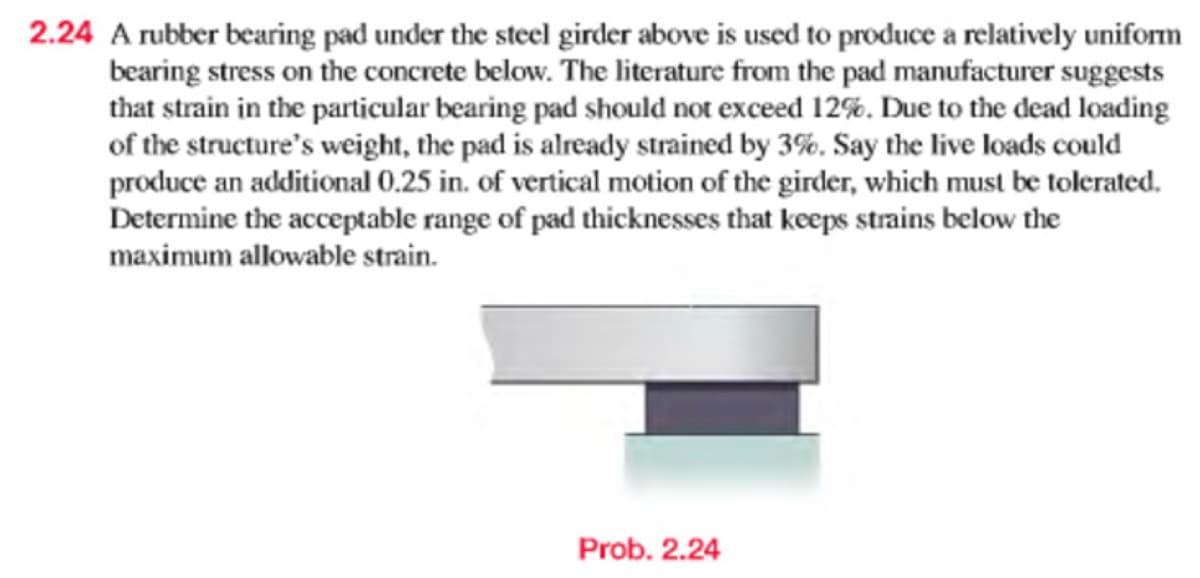2.24 A rubber bearing pad under the steel girder above is used to produce a relatively uniform bearing stress on the concrete below. The literature from the pad manufacturer suggests that strain in the particular bearing pad should not exceed 12%. Due to the dead loading of the structure's weight, the pad is already strained by 3%. Say the live loads could produce an additional 0.25 in. of vertical motion of the girder, which must be tolerated. Determine the acceptable range of pad thicknesses that keeps strains below the maximum allowable strain.
2.24 A rubber bearing pad under the steel girder above is used to produce a relatively uniform bearing stress on the concrete below. The literature from the pad manufacturer suggests that strain in the particular bearing pad should not exceed 12%. Due to the dead loading of the structure's weight, the pad is already strained by 3%. Say the live loads could produce an additional 0.25 in. of vertical motion of the girder, which must be tolerated. Determine the acceptable range of pad thicknesses that keeps strains below the maximum allowable strain.
Elements Of Electromagnetics
7th Edition
ISBN:9780190698614
Author:Sadiku, Matthew N. O.
Publisher:Sadiku, Matthew N. O.
ChapterMA: Math Assessment
Section: Chapter Questions
Problem 1.1MA
Related questions
Question

Transcribed Image Text:2.24 A rubber bearing pad under the steel girder above is used to produce a relatively uniform
bearing stress on the concrete below. The literature from the pad manufacturer suggests
that strain in the particular bearing pad should not exceed 12%. Due to the dead loading
of the structure's weight, the pad is already strained by 3%. Say the live loads could
produce an additional 0.25 in. of vertical motion of the girder, which must be tolerated.
Determine the acceptable range of pad thicknesses that keeps strains below the
maximum allowable strain.
Prob. 2.24
Expert Solution
This question has been solved!
Explore an expertly crafted, step-by-step solution for a thorough understanding of key concepts.
Step by step
Solved in 2 steps

Knowledge Booster
Learn more about
Need a deep-dive on the concept behind this application? Look no further. Learn more about this topic, mechanical-engineering and related others by exploring similar questions and additional content below.Recommended textbooks for you

Elements Of Electromagnetics
Mechanical Engineering
ISBN:
9780190698614
Author:
Sadiku, Matthew N. O.
Publisher:
Oxford University Press

Mechanics of Materials (10th Edition)
Mechanical Engineering
ISBN:
9780134319650
Author:
Russell C. Hibbeler
Publisher:
PEARSON

Thermodynamics: An Engineering Approach
Mechanical Engineering
ISBN:
9781259822674
Author:
Yunus A. Cengel Dr., Michael A. Boles
Publisher:
McGraw-Hill Education

Elements Of Electromagnetics
Mechanical Engineering
ISBN:
9780190698614
Author:
Sadiku, Matthew N. O.
Publisher:
Oxford University Press

Mechanics of Materials (10th Edition)
Mechanical Engineering
ISBN:
9780134319650
Author:
Russell C. Hibbeler
Publisher:
PEARSON

Thermodynamics: An Engineering Approach
Mechanical Engineering
ISBN:
9781259822674
Author:
Yunus A. Cengel Dr., Michael A. Boles
Publisher:
McGraw-Hill Education

Control Systems Engineering
Mechanical Engineering
ISBN:
9781118170519
Author:
Norman S. Nise
Publisher:
WILEY

Mechanics of Materials (MindTap Course List)
Mechanical Engineering
ISBN:
9781337093347
Author:
Barry J. Goodno, James M. Gere
Publisher:
Cengage Learning

Engineering Mechanics: Statics
Mechanical Engineering
ISBN:
9781118807330
Author:
James L. Meriam, L. G. Kraige, J. N. Bolton
Publisher:
WILEY